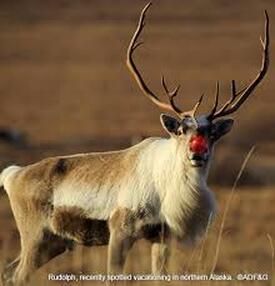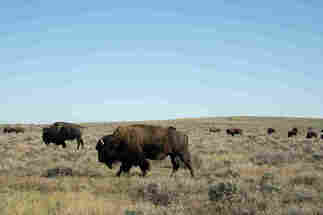|
by Jeff Stehm 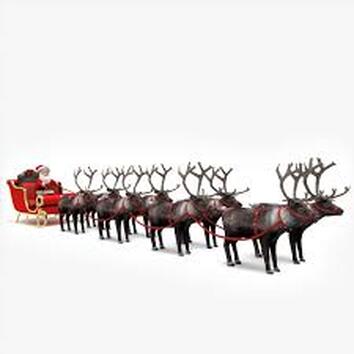 More rapid than eagles his coursers they came, And he whistled, and shouted, and called them by name: "Now, Dasher! now, Dancer! now Prancer and Vixen! On, Comet! on, Cupid! on, Donner and Blitzen! To the top of the porch! to the top of the wall! Now dash away! dash away! dash away all!" As leaves that before the wild hurricane fly, When they meet with an obstacle, mount to the sky; So up to the housetop the coursers they flew…. He sprang to his sleigh, to his team gave a whistle, And away they all flew like the down of a thistle. But I heard him exclaim, ere he drove out of sight-- “Happy Christmas to all, and to all a good night!” Excerpt from “A Visit from St. Nicholas” By Clement Clarke Moore Christmas is approaching and with it, undoubtedly, comes a yearning in the hearts of master naturalists for a better understanding of reindeer. So here are some fun facts about reindeer to entertain the holiday crowds.
And did you know that Rudolf’s red nose is not an anomaly. Most reindeer have red noses as a result of a dense network of capillaries that carry blood to the nose and keep it warm in the cold environment as well as help regulate the reindeer’s body temperature. Now if you really want to impress your holiday guests with the extraordinary depth of your master naturalist training, here are a few scientific points for recitation at Christmas dinner (be sure there is plenty of eggnog):
Sources: www.en.wikipedia.org/wiki/Reindeer www.pbs.org/newshour/science/7-things-didnt-know-reindeer www.britannica.com/animal/reindeer www.mentalfloss.com/article/29470/11-things-you-might-not-know-about-reindeer www.livescience.com/56310-reindeer-facts.html Happy Holidays and Merry Christmas!
0 Comments
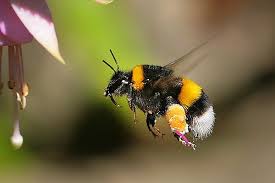 Submitted by Barry Buschow Commercial pumpkin growers routinely rent honey bees so they have enough insects to pollinate their crops, but a new study published in the Journal of Economic Entomology suggests that wild bees can do the job for free. The three-year study found that wild bumble bees and squash bees could easily handle the pollination required to produce a full yield of pumpkins in all of the tested commercial fields, according to Carley McGrady, the lead author of the study. The pumpkin study was part of a broader initiative, called the Integrated Crop Pollination Project, or Project ICP (http://icpbees.org/), which was headquartered at Michigan State University and funded by the U.S. Department of Agriculture’s Specialty Crop Research Initiative. To read more, click here. Big Money Is Building A New Kind Of National Park In The Great Plains NPR, Nate Hegyi, December 8, 2019 · 6:00 AM ET
 Richmond Times-Dispatch, November 30, 2019 (BY DEVI LOCKWOOD, The New York Times) (submitted by Charlene Uhl, Class X) Physiologically, the hibernation period is the strangest, and the most compelling, to researchers. When a bear hibernates, its metabolic rate and heart rate drop significantly. It does not defecate or urinate. The amount of nitrogen in its blood rises sharply, without damaging the kidneys or liver. The animal becomes resistant to insulin but doesn't suffer from fluctuations in its blood sugar levels. To read the full article, click here. 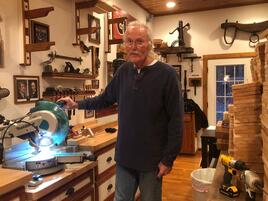 By SANDY HAUSMAN, Radio IQ WVTF, NOV 29, 2019 (submitted by Barry Buschow) Hundreds of people spends each spring and summer checking on baby birds in their neighborhood. They’re part of a national effort to bring back bluebirds after their population dropped 90%. You might expect those volunteers to retire in the fall, but one bird lover from Virginia is busier than ever. 200 years ago, eastern bluebirds were common in Virginia. Settlers would find their nests in the holes of trees, but the situation changed as farmers took down forests and non-native species arrived in America – cavity nesters that compete with bluebirds. “One of them was house sparrows, and another is the starling, and those two species of birds are now the two most populous of all bird species in North America, ” says Clark Walter, a man who played professional basketball in Europe in his youth. He stands 6-foot-six but has great compassion for smaller creatures. “Bluebirds are tiny little things, and they just weren’t winning the war against the starlings and the house sparrows,” he explains. Now retired from the Cleveland Zoological Society, Walter knew it was possible to help bird populations recover. “I’ve had some exposure with Andean condors into Venezuela or Trumpeter swans in the state of Ohio, but I didn’t know much about my own backyard,” Walter admits. So he became a master naturalist and built a trail through his Albemarle County neighborhood, putting up specially designed boxes for bluebirds. He turned his garage into a cozy workshop with a wood stove and more than a dozen antiques, including a cabinet with 125 tiny drawers that supplied a 19th century pharmacy. “They held different medicines, things like arsenic and turpentine and other sorts of things that we probably wouldn’t want to take today,” he muses Now they’re filled with screws and nails he uses to build cedar bluebird boxes he sells for the cost of the materials. In his first year, he made 65 of them. “The following year I was building a couple of hundred," Walter recalls. "The next year 400, and the next year 600, and a couple of years ago 700.” Each comes with a pole and a baffle that protects the birds, their eggs and babies from predators. “We love housecats, and we have one of them, but they take a heavy toll on the bird population, in the billions. Also, snakes, raccoons and bears.” Actually, there’s no stopping the bears. Walters says they’ve destroyed five bluebird houses in the last three years in his neighborhood alone. Still, the birds are prolific, often raising two broods in a season and sometimes three or four. “You clear out the old nest and that prompts the parents to build a new one," he explains. "It takes them a day or two, and then they lay another set of eggs and raise them until fledging.” The bluebird population has grown more than two percent a year since the sixties, but Clark Walter plans to keep building boxes. He’ll finish this year’s batch at the end of November. Then it’s on to his next project -- a seasonal business called Captain Breck's Rum Cakes. Like the birds, he’s a productive guy. Next month, in the kitchen he shares with his sweetheart Connie Friend, he’ll bake, pack and ship a thousand cakes made with twenty cases of rum. Click Here for Audio of this Interview. |
Have a blog or blog idea?
Let us know (click) Other Blogs
VA Native Plant Society - click Brenda Clement Jones - click John Muir Laws' Blog - click Megan's Nature Nook - click Categories
All
Archives
September 2023
Blog Administrator:
Kathleen A. VMN since 2018 |
